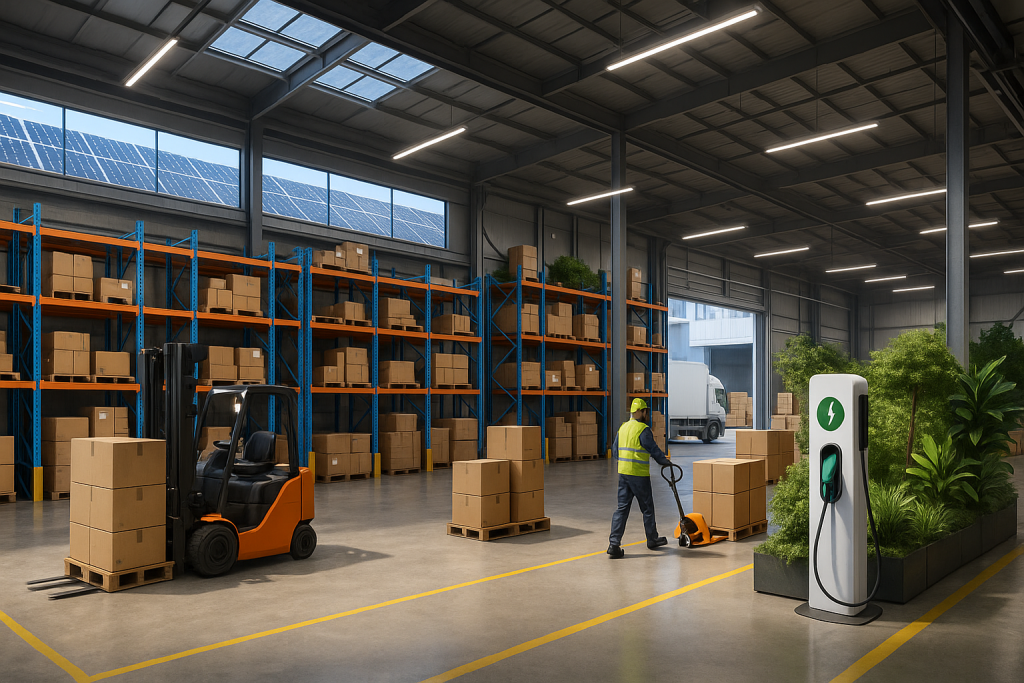By Martin Vassilev / 7 Nov, 2025
The logistics industry is at a pivotal crossroads in 2025. Sustainability is no longer an optional strategy—it’s a business imperative. Warehouses are evolving from energy-draining facilities into smart, eco-efficient ecosystems. A sustainable warehouse reduces emissions, cuts energy costs, and improves brand credibility in an era where environmental responsibility defines success.
From adopting green building materials to integrating AI-driven logistics systems, companies are rethinking every layer of their supply chain. According to the International Energy Agency (IEA), logistics operations account for over 10% of global CO₂ emissions—a figure that forward-thinking businesses are now determined to lower.
The foundation of a sustainable warehouse starts with the building itself. Using low-carbon concrete, recycled steel, and insulated wall panels can drastically reduce embodied emissions. In Canada, builders can also benefit from LEED-certified design standards that promote energy efficiency and reduced waste.
Strategically placed skylights, LED motion sensors, and solar glass roofing are transforming how energy is consumed in logistics hubs. For example, ByExpress’s Calgary–Dallas logistics hubs are integrating solar infrastructure to power lighting, automation, and temperature control systems year-round.
Energy-efficient HVAC systems and temperature zoning help minimize energy waste. Advanced IoT sensors track temperature, humidity, and airflow, ensuring optimal conditions for products—especially in temperature-controlled warehousing where sustainability meets precision.
Learn more about how temperature management supports operational excellence in temperature-controlled warehousing.
The integration of renewable energy is reshaping warehouse management. Solar panels can offset up to 70% of energy needs, while micro wind turbines complement supply during off-peak sunlight hours.
Warehouses that connect to renewable energy grids or use battery storage gain energy independence and resilience during high-demand periods. The U.S. Department of Energy provides incentives for businesses adopting clean energy logistics through its Better Buildings Initiative.
Battery systems now store surplus solar energy to power nighttime operations. Smart grids automatically balance consumption between high and low-demand periods, ensuring minimal wastage. This is particularly effective in large-scale facilities such as logistics hubs in Ottawa and Washington, which operate across variable climates.
The AI revolution in logistics has brought intelligent automation that reduces human error and unnecessary machine downtime. Automated guided vehicles (AGVs) and robotic picking systems use real-time energy optimization—powering down when idle and rerouting for energy efficiency.
ByExpress highlights this transformation in its piece on how AI is transforming logistics in 2025, where companies adopting AI-powered solutions report up to 30% lower energy costs and 20% faster order processing times.
IoT devices monitor every aspect of warehouse performance—from conveyor belts to lighting systems—using predictive analytics to detect inefficiencies. Cloud-based dashboards allow managers to make real-time decisions, cutting both emissions and costs.
For deeper insight into connected systems, see Integrating AI in Warehouse Management.
Packaging is a major contributor to supply chain waste. Switching to biodegradable materials, compostable wraps, and reusable containers aligns warehouse operations with environmental goals.
Companies are also rethinking the packaging-to-product ratio, reducing filler material and optimizing box sizes to minimize fuel consumption during transportation.
Green logistics extends beyond product delivery. Reverse logistics enables the return, refurbishment, and recycling of goods, reducing landfill waste. ByExpress’s insights on how reverse logistics can save your bottom line showcase how circular systems are turning sustainability into profitability.

Maximizing warehouse space not only improves throughput but also reduces environmental impact. Vertical racking, mobile shelving, and modular layouts optimize space while cutting the footprint required for expansion.
Learn about advanced strategies in how to improve warehouse space utilization, where space optimization leads directly to lower emissions and operational costs.
LED smart lighting systems adjust brightness based on motion and time of day, while AI-driven HVAC systems maintain temperature consistency without overuse. Together, these innovations can lower energy bills by up to 40% annually.
Green warehouses extend sustainability beyond their walls. Electrifying delivery fleets is one of the most impactful changes logistics companies can make. Vehicles powered by renewable energy charging stations help minimize total supply chain emissions.
Companies in regions like Vancouver and Toronto are integrating EV fleets with advanced route optimization, as highlighted in smart distribution management.
Hydrogen and biofuel-powered vehicles are gaining momentum for long-haul freight. Many organizations also engage in carbon offset programs supported by governments and organizations like Natural Resources Canada (NRCan) through the Greening Government Strategy.
Sustainability efforts must be measurable. Tracking KPIs such as energy use per pallet, CO₂ per shipment, and water consumption ensures accountability and drives improvement.
Warehouses can implement green dashboards to track and visualize sustainability metrics across all facilities, improving transparency and compliance with global ESG standards.
Businesses should pursue ISO 14001 (Environmental Management) certification to demonstrate sustainability excellence. Government grants and tax credits for certified operations further incentivize adoption.
Eco-efficiency directly translates to profit. Energy-efficient facilities reduce power bills, while automation cuts labor costs. Green-certified warehouses can also command higher property value and attract sustainability-conscious clients.
Companies implementing green logistics practices, like those outlined in the Future of Warehouse Automation, consistently outperform competitors on cost savings and reputation.
Today’s consumers prefer sustainable brands. Businesses that communicate their environmental initiatives through transparent reporting and ESG storytelling see stronger loyalty and investor confidence.
In 2025, the convergence of automation, AI, and green logistics will redefine what it means to operate a modern warehouse. From data-driven energy use to carbon-neutral shipping, the goal is clear: build operations that serve both business growth and planetary health.
Companies adopting sustainable practices today are positioning themselves at the forefront of the logistics revolution. The next generation of warehouses will be smarter, cleaner, and more resilient—designed not just to move goods, but to move the industry forward.
A sustainable warehouse minimizes environmental impact through energy efficiency, renewable energy use, waste reduction, and optimized logistics practices.
Automation reduces human error, energy consumption, and resource waste. AI systems manage energy loads dynamically, ensuring no power is wasted on idle machinery.
While initial costs can be higher, long-term savings in energy, waste management, and maintenance quickly outweigh the investment.
Both Canada and the U.S. offer grants and tax credits for companies adopting sustainable energy solutions and eco-friendly logistics systems.
Start with an energy audit, introduce IoT monitoring, transition to renewable energy, and optimize your supply chain with data analytics for long-term impact.
For sustainable logistics solutions and warehouse management strategies tailored to your business, contact ByExpress today and discover how to future-proof your operations for 2025 and beyond.

“Thanks to Byexpress all my shipping and fulfillment costs are in line now”

“All my issues were solved by Byexpress team that I had with pervious 3pl provider.”

“Thank you Byexpress team could not done it without you guys.”

“Their integration and customer service were the key for me”

“Outstanding delivery service! The package was well-packaged, and
the delivery team was professional and courteous”

“Great and knowledgeable team to work with.”

Thanks, guys, for reducing my shipping rates
Ottawa Office
2411 Holly Lane
Ottawa, ON, K1V 7P2
Toronto Office
13-280 West Beaver Creek Road Unit #136
Richmond Hill, ON, L4B 3Z1
Alexandria Office
173 Kenyon Street West
Alexandria, ON, K0C 1A0
Montreal Office
4388 Saint-Denis Street Unit #200
Montreal, QC, H2J 2L1
California Office
155 North Riverview Drive
Anaheim Hills, CA, 92808
Call Us
Toll-Free: 1-866-744-7122
Local : 613-739-3000
Email Us
Multilingual Services










